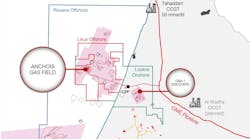NOISE & VIBRATION: Vibration analysis pinpoints faults and extends machine life
"All noise comes from vibration, but that does not mean it is harmful" explains Daniel Eriksson, of Vikab. The company is built around its ability to identify those vibrations that are harmful, and Eriksson believes that it can offer a valuable service to companies in the offshore sector.
Vikab provides a vibration consultancy service that is saving money for customers in the marine, aircraft, and other industries. Clients include Saab Aerospace, Volvo, ABB, and Scania, all dependent on the performance and reliability of rotating machinery.
Because the principle is the same with all machinery, Vikab's technicians can be working on a ship's engine one day and a navigation gyro the next. Daniel Eriksson now believes that vibration analysis could also give the offshore industry an opportunity to save money and down time. It can also help reduce spares inventories, in that the service can be used to prevent failure and perform predictive maintenance that will prolong the life of turbines, pumps, compressors, generators, and other vital machines.
Allowable vibration levels
Eriksson also maintains that vibration analysis of new machinery can save a great deal of grief in the future, if the acceptable vibration parameters are specified at the time of purchase. He argues that it can be a lot cheaper to check a newly delivered machine for abnormal vibrations when it arrives at a supply base, than to wait until it has been in use offshore or, even more significantly, subsea.
Fractionally misaligned bearings and unbalanced shafts will create abnormal wear and cause the machine to fail before its time. Although it may not be easy to run a machine before it is fully installed, Eriksson believes that vibration monitoring makes it possible to identify potential sources of failure in time for the manufacturer to rectify the defect.
The company also supplies a number of products that enable customers to carry out their own vibration monitoring. Strategically placed transducers can provide a continuous watch on a vital piece of equipment and sound an alarm if vibrations indicate an impending problem.
The Vikab service can reasonably be compared to a flying physician. Working from offices in the old control tower at Norkoping Airport in Sweden, the company's small team of experienced technicians will travel any where in the world in response to a call to check a machine that is producing abnormal vibrations.
Analysis and rectification
Speed of response is important because the rapid analysis of a problem machine can make the difference between an inexpensive adjustment and a major component failure. The service has the important advantage of enabling a diagnosis to be performed without dismantling the machine or even stopping it. Experience is a major asset provided by Vikab technicians who will typically attach transducers to critical points around the machine.
Specially developed Vikab software on a laptop computer will analyze the vibrations and compare them with published ISO international standards or with their own experience of similar machines. This makes it possible for the Vikab technician to not only identify which bearing may be at fault, but even which part of the bearing that is malfunctioning.
Overall vibration is made up of a number of sources within the machine, so it is necessary to isolate each individual source. The analysis will study the measurement and alignment frequencies and cavitation, which makes it possible to specify whether it is, for example, an alignment problem or a gear malfunction. Then, it becomes possible to look for problems such as balancing, bearing alignment, or whether a rotor is centered within its stator.
Once the problem has been identified, Vikab also will endeavor to rectify it. Eriksson says his technicians travel equipped with tools, such as laser alignment instruments, that enable them to resolve the problem at the same time.
Since many users prefer to perform their own vibration analysis, the company has found a ready market for its book "Vibration in rotating machinery - recommendations for procurement." This is supplied on CD and gives detailed data on a wide range of machinery, as well as information on how to deal with others, for which specifications are not included. Revisions are provided every six months, and these ensure that users are equipped to ensure machinery achieves its optimum performance and a full working life.
For more information contact Daniel Eriksson, Vikab. Tel: +46 11 14 22 00, Fax: +46 11 14 22 01, Email: [email protected].




